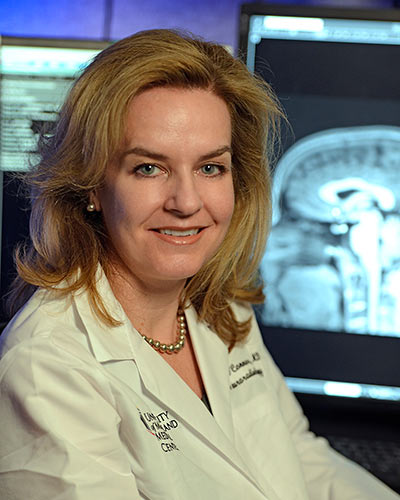March 02, 2018 | David Kohn

University of Maryland School of Medicine Researcher Finds That Increases Have Flattened In the Past 15 Years
A new study has found that although radiology research by women has increased significantly over the past five decades, the rate of this increase has leveled off since 2000.
“This is both a positive and a negative result,” says Erin O’Connor, MD, assistant professor of diagnostic radiology and nuclear medicine at the University of Maryland School of Medicine (UMSOM), and the lead author of the paper. “The good news is that radiology publications by female researchers are much more common than they were in 1970. But at the same time, these increases seem to be flattening to a certain extent.”
The paper was published recently in the journal Academic Radiology.
Dr. O’Connor and her colleagues focused on authorship between 1970 and 2016. They examined articles in two key radiology journals, Radiology and the American Journal of Roentgenology, looking at the gender of the first, corresponding and last authors.
Generally, the first author is the scientist who contributed most to the work. Typically, the senior researcher is listed last, and the corresponding author takes primary responsibility for communicating with the journal during and the process of review and publication.
First authorship among females in Radiology demonstrated a 31 percent increase from 1970 to 2016; female corresponding authors showed a 16.5 percent increase from 1980 to 2016; and female senior authors demonstrated a 16.5 percent increase from 1970 to 2016. The percentage of female first authors in AJR demonstrated a 32.2 percent increase from 1970 to 2016, female corresponding authors demonstrated a 24.3 percent increase from 1970 to 2016 and senior female authors demonstrated a 13.5 percent increase from 1970 to 2016.
Overall, during the 46 years, 23.5 percent of first authors were female, 22.2 percent of corresponding authors were female, and 15.2 percent of last authors were female.
After 2000 however, the rate of increase in female first and corresponding authorship decreased by 47 percent. In contrast, the proportion of female last authorship continued to increase at the rate that it had since 1970.
Dr. O’Connor first got interested in this topic because other scientific fields that have shown that gender heterogeneous working groups produce higher-quality science, judging from the fact that papers by these groups receive a higher numbers of citations. In the past, Dr. O’Connor and colleagues have examined this issue for articles published in Radiology and the American Journal of Roentgenology, and found similar findings for radiology - mixed gender, compared to homogeneous gender, authorship teams were associated with increased citations of their publications, suggesting that they had a greater scientific impact.
Dr. O’Connor theorizes that the decrease in academic productivity may be related to reductions in the growth of female radiology faculty and trainees. She argues that more should be done to encourage women to pursue careers in academic radiology.
Women remain underrepresented at the associate professor and professor ranks and in upper level radiology department administration.
The proportion of female radiology faculty, radiology trainees and graduating medical students substantially increased from 1970 to 2016. The percent of women holding full-time radiology faculty positions rose from 8.6 percent in 1970 to 30.2 percent in 2016. Female radiology trainees increased from 19.2 percent in 1980 to 26.7 percent in 2015. Overall, female medical student proportions rose much more rapidly, from nine percent in 1970 to nearly 48 percent in 2016.
“Gender equity in academic medical research is a deeply important topic,” said E. Albert Reece, MD, PhD, MBA, University Executive Vice President for Medical Affairs and the John Z. and Akiko K. Bowers Distinguished Professor and Dean, University of Maryland School of Medicine. “This new paper from Dr. O’Connor and her colleagues shows that we must keep working to ensure that female scientists continue to receive opportunities to do more in all areas of academic medicine and research.”
About the University of Maryland School of Medicine
Commemorating its 210th Anniversary, the University of Maryland School of Medicine was chartered in 1807 as the first public medical school in the United States. It continues today as one of the fastest growing, top-tier biomedical research enterprises in the world -- with 43 academic departments, centers, institutes, and programs; and a faculty of more than 3,000 physicians, scientists, and allied health professionals, including members of the National Academy of Medicine and the National Academy of Sciences, and a distinguished recipient of the Albert E. Lasker Award in Medical Research. With an operating budget of more than $1 billion, the School of Medicine works closely in partnership with the University of Maryland Medical Center and Medical System to provide research-intensive, academic and clinically-based care for more than 1.2 million patients each year. The School has over 2,500 students, residents, and fellows, and nearly $450 million in extramural funding, with most of its academic departments highly ranked among all medical schools in the nation in research funding. As one of the seven professional schools that make up the University of Maryland Baltimore campus, the School of Medicine has a total workforce of nearly 7,000 individuals. The combined School and Medical System (“University of Maryland Medicine”) has an annual budget of nearly $6 billion and an economic impact in excess of $15 billion on the state and local community. The School of Medicine faculty, which ranks as the 8th-highest public medical school in research productivity, is an innovator in translational medicine, with 600 active patents and 24 start-up companies. The School works locally, nationally, and globally, with research and treatment facilities in 36 countries around the world. Visit medschool.umaryland.edu/
Contact
Office of Public Affairs
655 West Baltimore Street
Bressler Research Building 14-002
Baltimore, Maryland 21201-1559
Contact Media Relations
(410) 706-5260
